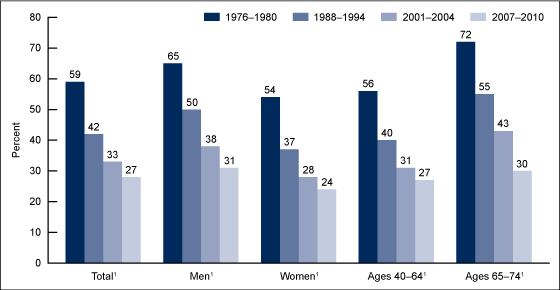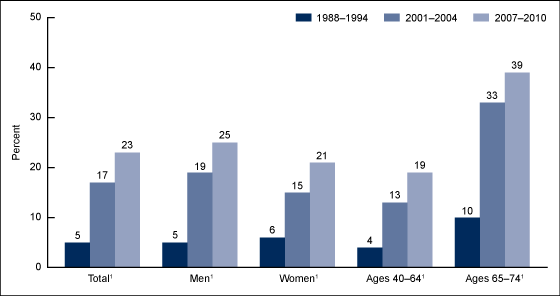Low density lipoprotein epidemiology and demographics: Difference between revisions
Rim Halaby (talk | contribs) |
Rim Halaby (talk | contribs) No edit summary |
||
| Line 4: | Line 4: | ||
==Overview== | ==Overview== | ||
From 1976–1980 through 2007–2010, for U.S. adults aged 40–74, a decrease was observed in the prevalence of high LDL-cholesterol (LDL–C) from 59% to 28%, as well as an increase in adults using lipid-lowering medications and consuming a diet low in saturated fat. Despite recent advances in medical treatment, high LDL-C remains a significant public health problem in the United States, with more than one-quarter of adults aged 40–74 having high LDL–C. | From 1976–1980 through 2007–2010, for U.S. adults aged 40–74, a decrease was observed in the prevalence of high LDL-cholesterol (LDL–C) from 59% to 28%, as well as an increase in adults using lipid-lowering medications and consuming a diet low in saturated fat. Despite recent advances in medical treatment, high LDL-C remains a significant public health problem in the United States, with more than one-quarter of adults aged 40–74 having high LDL–C.<ref name=Report>Kuklina EV, Carroll MD, Shaw KM, Hirsch R. [http://www.cdc.gov/nchs/data/databriefs/db117.htm Trends in high LDL cholesterol, cholesterol-lowering medication use, and dietary saturated-fat intake: United States, 1976–2010.] NCHS data brief, no 117. Hyattsville, MD: National Center for Health Statistics. 2013.</ref> | ||
==Epidemiology and Demographics== | ==Epidemiology and Demographics== | ||
Revision as of 13:49, 27 September 2014
Template:Low density lipoprotein Editor-In-Chief: C. Michael Gibson, M.S., M.D. [1]; Associate Editor(s)-in-Chief: Rim Halaby, M.D. [2]
Overview
From 1976–1980 through 2007–2010, for U.S. adults aged 40–74, a decrease was observed in the prevalence of high LDL-cholesterol (LDL–C) from 59% to 28%, as well as an increase in adults using lipid-lowering medications and consuming a diet low in saturated fat. Despite recent advances in medical treatment, high LDL-C remains a significant public health problem in the United States, with more than one-quarter of adults aged 40–74 having high LDL–C.[1]
Epidemiology and Demographics
Prevalence
Overall, the prevalence of high LDL–C significantly decreased from 59% in 1976–1980 to 42% in 1988–1994, and to 33% in 2001–2004, reaching 27% in 2007–2010.
The decrease in the prevalence of high LDL is paralleled by an increase in the use of cholesterol-lowering medication that grew from 5% in 1988–1994 to 17% in 2001–2004, and reached 23% in 2007–2010. In addition, the percentage of adults meeting guidelines for low saturated-fat intake increased significantly from 1976–1980 to 1988–1994, from 25% to 41%, but no significant change occurred from 1988–1994 through 2007–2010.
Shown below is a diagram depicting the age-adjusted prevalence of high LDL cholesterol among adults aged 40–74, by sex and age in the United States between 1976–1980 and 2007–2010. (Source: CDC/NCHS, National Health and Nutrition Examination Survey.)
Shown below is a diagram depicting the age adjusted use of cholesterol-lowering medications among adults aged 40–74 in the United States between 1988–1994 and 2007–2010. (Source: CDC/NCHS, National Health and Nutrition Examination Survey.)
Shown below an image depicting the age-adjusted trends in prevalence of high LDL cholesterol, use of cholesterol-lowering medications, and low saturated-fat intake among adults aged 40–74 in the United States between 1976–1980 and 2007–2010.
Gender
Between 1976–1980 and 2007–2010, the prevalence of high LDL–C significantly decreased for men from 65% to 31%.
The prevalence of high LDL–C also significantly decreased for and women from 54% to 24% between 1976–1980 and 2007–2010.
Age
Between 1976–1980 and 2007–2010, the prevalence of high LDL–C significantly decreased for adults aged 40–64 (56% to 27%) and 65–74 (72% to 30%).
References
- ↑ Kuklina EV, Carroll MD, Shaw KM, Hirsch R. Trends in high LDL cholesterol, cholesterol-lowering medication use, and dietary saturated-fat intake: United States, 1976–2010. NCHS data brief, no 117. Hyattsville, MD: National Center for Health Statistics. 2013.

